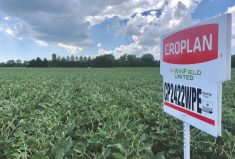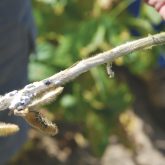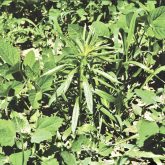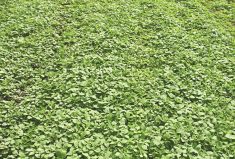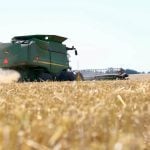With so many stories about resistance hitting the farm news in the last five years, any new stories about chemical resistance on the farm now tend to generate one of two reactions: disinterest (approaching boredom) or a touch of hypersensitivity. Neither is the best reaction, especially with all the new learnings about the possibilities of disease resistance.
Weed control is probably the main culprit, especially with the spread of glyphosate resistance in a growing number of weed species. One company rep confided recently that when she makes presentations to growers, she can see their eyes glazing over at the mere mention of herbicide resistance. The attitude seems to be, “We know what you’re going to say, we’ve heard the message, and we’ve made the changes we need to make.”
Maybe that’s why there’s this hypersensitivity to disease resistance to fungicides. It’s been a topic of discussion, both in U.S. and Canadian farm publications, and at conferences and field days. Yet for many reasons, fungicide resistance isn’t grabbing growers’ attention.
Two years ago, there were cases in the central U.S. where soybean plants infected with frog-eye leaf spot were found to be resistant to the strobilurin fungicide class. Now, there are reported concerns being raised at the prospect of diseases like northern corn leaf blight developing some level of resistance.
It’s important to note that as of now, there have be no confirmed cases of fungicide resistance to any diseases found in corn — in either the U.S. or in Canada. There have also been only limited cases of resistance in soybeans found in the U.S., although in wheat, there’s some indication that Cornell University has found an isolate of fusarium head blight that is tolerant to one of the triazole products.
But should fungicide resistance be a concern for grain and oilseed producers?
For the time being, the answer is probably no, say a number of different sources. In Eastern Canada, growers enjoy the benefits of longer rotations compared to U.S. growers, who rely more on continuous corn or a corn-soybean rotation.
Read Also

In the combine
Jeff Rowe, CEO of the Syngenta Group, doesn’t often get home to his farm near Princeton, Illinois. He’s usually operating…
But the biggest impediment to developing fungicide resistance is the complexity of the “disease triangle” — the presence of the disease pathogen, a suitable host and the right environmental conditions for that disease to develop.
In diverse cropping rotations, those three coincide at much lower frequencies. Now compare that to herbicide resistance, where weed species can grow and propagate regardless of the crop in the field. Canada fleabane, for instance, has the potential to release thousands of weed seeds, which all have that same potential to grow and release thousands more.
“If you look at a field, you’ll have that Canada fleabane plant that will germinate every year, no matter what the crop species is,” says Rob Miller, technical development manager for BASF for Eastern Canada.
That’s very different from diseases, Miller says. “That disease will not develop every year, unless there’s that specific host crop for it to develop. So if you have a diverse crop rotation, the risk of developing resistance is significantly lower.”
Physiology and frequency
Because of the sheer number of weed seeds produced, and because of the selection pressure caused by a single-mode-of-action approach in herbicides, weed resistance develops more readily than disease resistance.
But other factors are at play too.
“One of the misconceptions is that fungicides extend maturity, but basically, the maturity is set by the genetics,” says Miller. He adds that when a plant is under stress, be it from disease or drought, it shuts down prematurely. “So it (the fungicide) is actually increasing that ‘healthy period’ to allow the crop to reach physiological maturity, so you don’t get that premature die-down like you normally would. Because when a plant goes into stress it releases ethylene and that’s when it starts to trigger senescence. And some of the strobilurins like Headline decrease that ethylene release, which is why we talk about the stress tolerance and the increased plant health, so it doesn’t just die prematurely; it reaches its full physiological maturity, then you get a rapid die-down.”
In terms of frequency, more farmers in the U.S. are using fungicides than here in Canada. Added to that are the shorter rotations in the U.S. (corn-soybeans) and their greater reliance on continuous corn compared to Canada.
According to Shawn Brenneman, agronomic sales manager with Syngenta, the use of fungicides as a type of growth regulator in Canada is also lower than in the U.S.
“When you look at corn and soybeans, it’s still relatively low,” Brenneman says, noting that usage rates in the U.S. are only around 25 per cent. “Here in Canada, we’re still around 15 per cent, maybe up to 20 per cent now, between tassel application and that early application. But I’d say it’s still less than a quarter of the acres out there. The fact that we’re not spraying every crop, every year, there are a lot of different factors with corn, and it really depends on the weather, the environment, how even is the crop, how did it go in or the planting dates. There are a lot of different variables in corn that growers look at to decide whether to spray or not, unlike wheat where it’s automatic.”
One comment that’s often framed as a complaint from growers can actually be turned into a positive, and that’s the lack of longevity in corn hybrids and soybean varieties. It used to be that growers had their favourites, but now within a four- or five-year span, the seed industry’s development pipeline usually comes up with new hybrids and varieties, boasting improved or enhanced traits including disease resistance. So what was once viewed as a drawback to modern plant breeding is now turning into a positive.

Modes of action
Another factor that both Brenneman and Miller cite that effectively lowers the risk of developing resistance is the approach to modes of action in fungicides compared to herbicides. Herbicides are more vulnerable because of their reliance on a single mode of action — like an ALS inhibitor (Classic) or an HPPD inhibitor (Callisto) or an EPSP synthase inhibitor (glyphosate). Single modes are easier to overcome in a weed species that returns to a field year after year. But fungicide technologies have evolved to more of a two- or multiple-mode-of-action approach.
“From a sustainability standpoint, you’ll probably see a lot of the newer fungicides that come to the market have two modes of action,” says Miller, citing BASF’s marriage of a strobilurin and a triazole to create Twinline. “So both products would have activity on a target disease. Growers are thinking of using multiple modes of action in herbicides because they understand that. And even talking about fungicides and multiple modes of action, they’re starting to relate to what’s going on with glyphosate resistance, and they’re saying, ‘We can’t rely on one mode of action, we have to use crop rotation and products with two modes of action on that target species.’”
Brenneman agrees that two modes are better than one, but he also says it makes sense for growers to adapt some of the herbicide-resistance strategies to mitigate the risk of fungicide resistance. In particular, it makes sense to rotate your chemistries, not just your crops and traits.
“From a corn perspective, try to understand the hybrids that you’re growing, and have that planned application, if you do need it, because the disease tolerances I’m finding in most hybrids continue to improve every year,” says Brenneman. “We’re not seeing as much northern corn leaf blight or rust in a lot of cases, so if you actually are picking a strong defensive hybrid, then that’s part of the battle — understanding the strengths and weaknesses of corn products you’re growing — which helps in the overall situation and planning.”
That’s actually another advantage on the fungicide side of the chemical industry; there’s more of an upside for the development of fungicides than there is for herbicides. As far back as 2003, extension personnel and university researchers cited a lack of development in herbicide technology. Certainly there was nothing that approached the game-changing status of glyphosate. Fungicides however, particularly those with multiple modes of action, are becoming more commonplace, with more in the development pipeline.
Mode of action versus active ingredient
But Albert Tenuta is concerned that key terms are being used interchangeably. “You have to be careful,” says
Tenuta, field crops pathologist with the Ontario Ministry of Agriculture, Food and Rural Affairs (OMAFRA). “All of the actives could be from the same family or the same chemistry, so they share the same mode of action. In most cases, there could be some subtle differences, but if a pathogen for instance, develops resistance to a certain active ingredient, it might be resistant not only to that one but more likely to that mode of action.”
It’s true, adds Tenuta, that there are lots of different active ingredients. But the industry is also finding new modes of action and new actives that haven’t been used in the past. And of course, the lengthening of crop rotations, using disease-resistant varieties and hybrids, rotating chemistries and tank mixing different modes of action are valuable tools in the tool box. The more such tools are used by growers, the greater the chance of reducing fungicide resistance as well as minimizing disease losses.
Says Tenuta, “It’s important for us as an industry, as a community, as stewards of not only the technology but of the land and agriculture, to do our best at maintaining the technology we have and incorporating new technologies, as well.”





